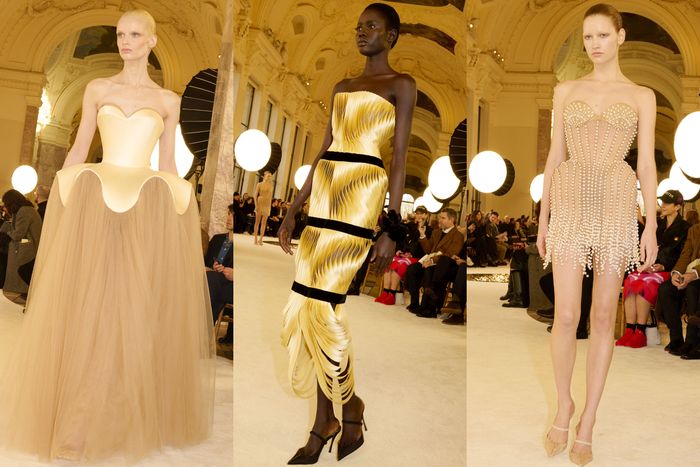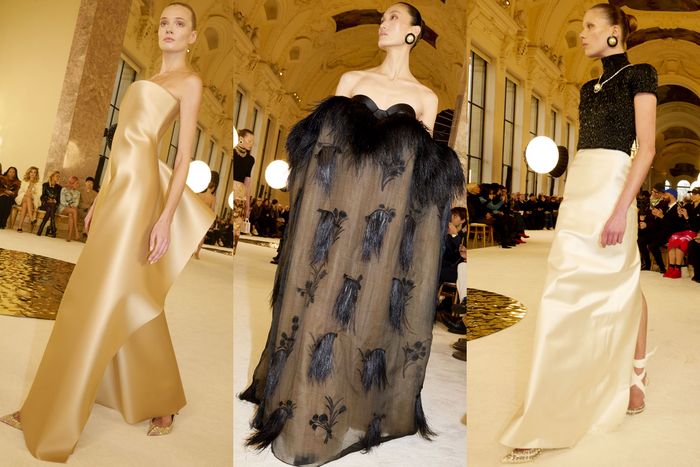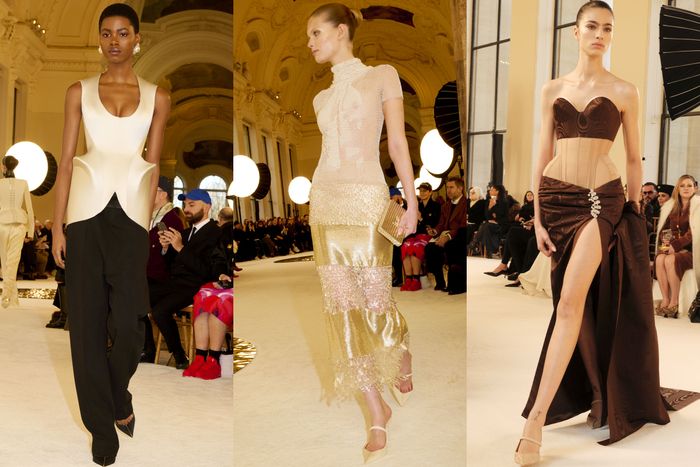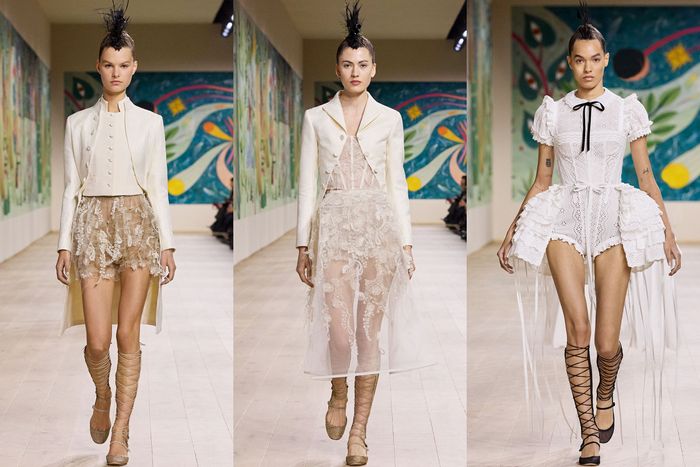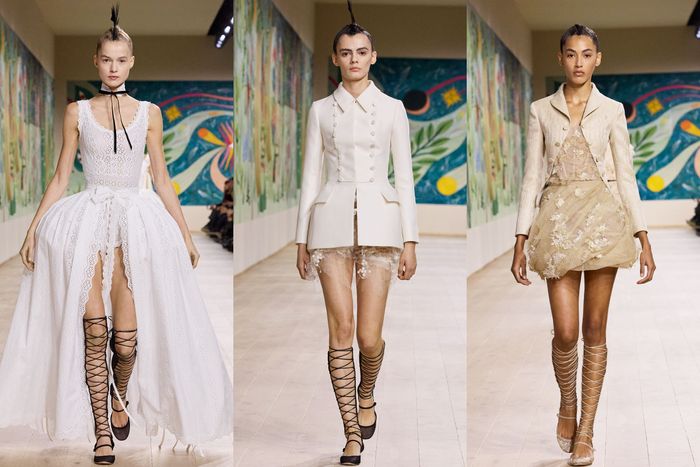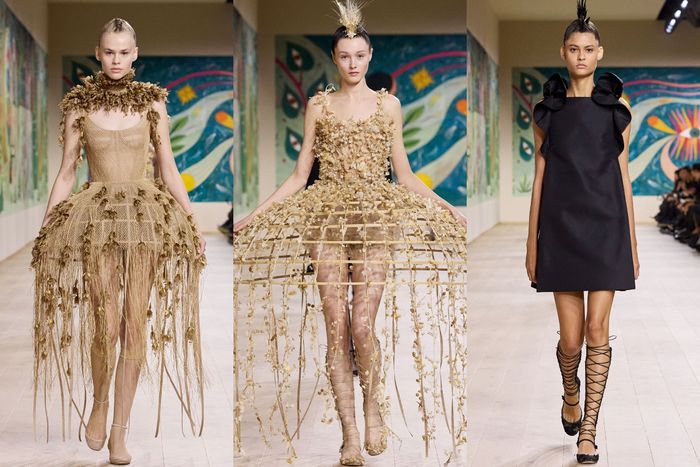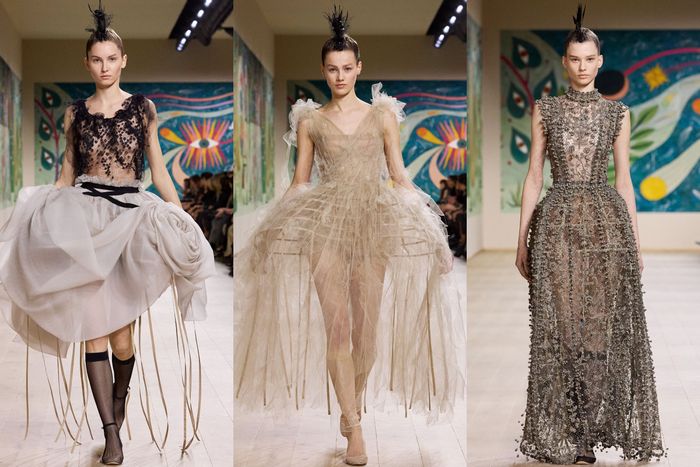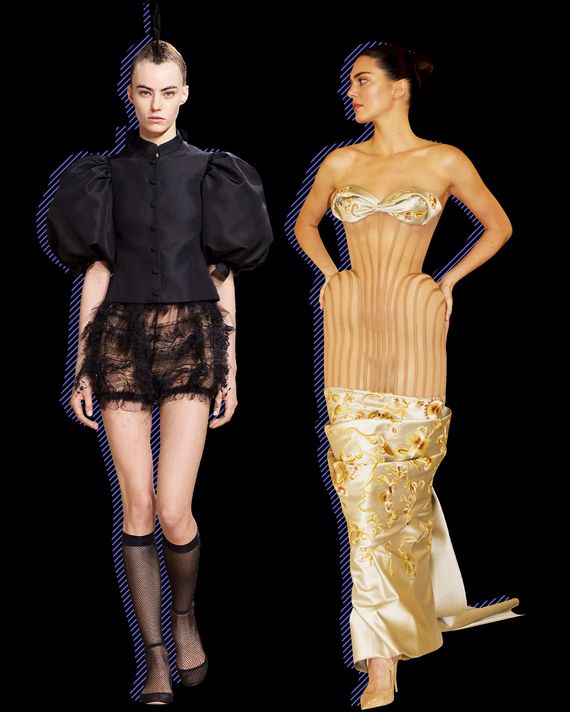
When a designer’s vision of beauty is at once frightening and funny, you know it’s contemporary. That’s true of Daniel Roseberry’s Schiaparelli, which kicked off the Paris spring couture shows on Monday. He said he was interested in the pursuit of perfection, and once you know that, the Barbie-like flawlessness of his models, their tight coiffures, their tiny corseted waists make sense. I looked for a pore among the girls and I couldn’t find one. Their faces seemed sprayed with glycerine.
Roseberry held his show in the light-filled Petit Palais, on a figure-eight runway marked off by several golden metal “pools” and surrounded by a small forest of big soft-box lights. Naturally, you thought of the movies or a photographer’s studio. The severe glamour of the dresses and suits, mostly in black, ivory and Champagne, with splashes of ostrich feathers — some conditioned and brushed to resemble monkey fur — also recalled the golden age of Hollywood and couture. Watching the models circle the room, their gaze directed not at the audience but somewhere just over our heads, I found myself completely absorbed in the moment, and by the dazzling details of the clothes.
And then Roseberry snapped his fingers, so to speak. He’s clever with a soundtrack. The final song was “Let the River Run,” from the 1988 movie “Working Girl.” Back then, the quest was for equality and a corner office; nowadays, it’s something very different and not entirely liberating. Social media and the wonders of digital technology have made people slaves to fashion, just as the rise of consumer culture did in the 19th century. But near the end of “Working Girl,” Melanie Griffith’s character says that she’s not going to take the whole thing so seriously anymore. There’s a similar knowingness in Roseberry’s work that keeps it amusing.
Of course, generations of designers have played with and redefined female glamour. Think of Thierry Mugler, Jean Paul Gaultier, and John Galliano, who a year ago put on that remarkable show for Margiela with most of his models cinched into corsets and with lots of transparency. In all his career, Galliano was never so focused on the body as he was in that show. And Roseberry says he has been hungry of late to understand more about the couture techniques of the great masters, mentioning Worth, Poiret, Saint Laurent, and Alaïa. He said, “Why does modern have to be simple? Can we do something that feels elaborated? Rigorous but with an element of fantasy — and without the tropes of surrealism?” (Surrealism is part of Elsa Schiaparelli’s legacy and, having unpacked it, Roseberry is eager to move on. His clients, judging from their outfits at the show, still love it.)
Curiously, Maria Grazia Chiuri of Dior is also more history-minded this season. “My house in Rome is full of books on the history of fashion,” she said. Her show on Monday unearthed the crinoline, among other historical forms.
And “Louvre Couture,” the first fashion exhibition at the Louvre Museum, just opened. Organized by Olivier Gabet, director of the decorative arts department, the superb exhibit displays 71 silhouettes and 30 accessories, from 1961 to the present, among objects from Byzantium to the Second Empire. Gabet didn’t want to alter the permanent exhibits of bronzes, tapestries, and other treasures to accommodate the clothes. As he said, “We changed nothing. We just added a layer of experience for the visitor.” But you can readily see the links between the fashion and the sources of inspiration. Forty-five houses from around the world are represented, and the museum, he said, insisted on choosing the pieces it wanted. If a house didn’t want the work of a former designer to be shown, then Gabet declined to take anything from the brand.
Roseberry is sincere in his efforts to learn more and in many ways, this collection was better than his fall couture show. Despite some of the exaggerated shapes, it felt more reduced, more considered. Among the standout looks were a strapless dress with a sweetheart neckline and a rippling peplum made of three layers of material (it looked as soft as leather, but the top layer was actually stretch satin) with a multilayered tulle skirt; a super-simple, strapless jumpsuit in palest-yellow satin with a light gather at the back; a bustier dress made of loose ribbons of saffron-yellow satin restrained by three horizontal bands in black velvet; and a number of stunning tailored looks following the S-bend of the back. Roseberry was as strong on the soft and delicate designs as he was on the more monumental forms.
But he must be aware that his molded shapes, his almost obsessive attention to anatomy, especially breasts and hips, and camera-ready beauty mimic the culture, and to a great extent mirror his audience. And I don’t think he’s making a joke of people’s obsession with the body — perfection gone crazy — as Mugler did with conventional glamour in the ’80s. Different time, different attitudes. No, I think Roseberry is serious about his craft and figuring out how to advance it for himself and keep it interesting. But the show certainly left the impression that he’s aware of the effect of such frightening perfection, and that at some level it should also be darkly funny.
One further point about Schiaparelli: When I was visiting the Louvre with Gabet, we paused before two 1960s designs from Cristóbal Balenciaga that happened to share a room with a design from Demna’s first couture show, in 2021, for the house. One of the Cristóbal designs was essentially a billowy cloud of white silk, for evening. Gabet noted that some of Balenciaga’s clients, notably Liliane de Rothschild and Mona Bismarck, loved to wear his conceptual pieces, perhaps as mark of their taste or independence. They were also collectors. I thought of Roseberry’s clients, dressed to commune with (and impress) each other. They are doing what clients have done for generations, since even before the age of Worth.
At Dior, Chiuri might be accused of infantilizing women, given the mini-crinis, frilly bloomers, and tiny tent dresses on her runway. And she’s the designer who famously put out a feminist-slogan T-shirt many years ago, and almost every season gives attention to a female artist with her set. Chiuri had a female archer shooting arrows down the runway four months ago. And now bloomers and tutus?
Well, let’s lighten up a bit. This is fashion and this is couture, where everything is made for an individual client. Suppose she loves the sharp cut of a jacket curving away from her body but doesn’t care for organza rompers or a twisted taffeta puffball miniskirt. In that case, she can ask for trousers or have the fitters at Dior adapt the silhouette to something else. Anything is possible. As Karl Lagerfeld used to say, “I only propose.”
I took away several things from this charming collection. One was the superb tailoring. In the past, her jacket styles have seemed a bit boring. The same Dior Bar jacket or a modest variation. This time, though, she had cuts inspired by historical menswear, including the opening coat in black wool embroidered at the edges with tiny flowers and vines made from black leather, and a black wool jacket with an embroidered vest buttoned to the front of the jacket (leave in or button out). Another jacket was made out of a common fabric used to inner line men’s coats but, of course, done with savoir-faire. Chiuri also turned a type of ribbon that’s typically used inside a garment as an embellishment — for tiny flowers. And she did other tailored styles with puffed, circa-1890s sleeves.
Was Chiuri doing a subtle historical timeline of women’s emancipation, through clothes? Perhaps. Another takeaway was the overall feeling of lightness, especially from the amount of lace (made in Italy, it looks almost broken up close and therefore less precious) and those wispy bits of tulle and lace under a strict jacket. I also loved the white cotton eyelet, for underpinnings and a mini-crini or two, and a new rendition, in black silk, of a trapeze dress that a young Saint Laurent did for Dior in 1958.
The only fault with this collection was that Chiuri showed too many of the big crinolines, dripping with vines like Spanish moss. And the knee-high, lace-up shoes — a Roman style she likes — looked fey. Her dream, and those soldierly jackets, needed a firmer footing.



